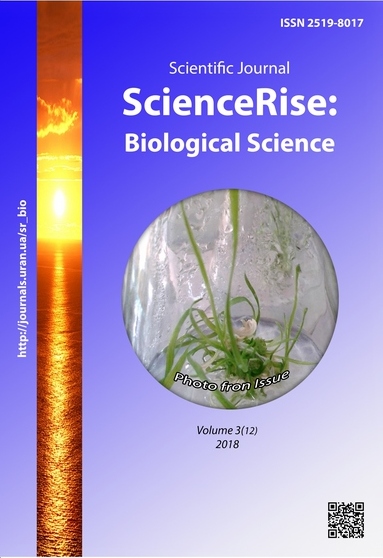Hygienic assessment of sanitary and chemical indicators of potable tap water quality in shallow water regions of Ukraine
DOI:
https://doi.org/10.15587/2519-8025.2018.135625Keywords:
potable tap water, quality that don’t meet the standards, groundwater, shallow water regionsAbstract
The aim of current research was to make the hygienic assessment of sanitary and chemical indicators of potable tap water quality in Ukraine in regions with the shortage of potable water, where drinking water is used from underground low-quality sources or the big water pipelines. While conducting the research, the following methods were used: sanitary-chemical, hygienic monitoring, and mathematical statistics. It was determined, that the groundwater and hybrid water supply are used for provision of shallow water regions with potable tap water. In some regions of Ukraine, the water of centralized supply of drinking water from underground sources is of inadequate quality, which is due to the following indicators: nitrates, fluorine, dry residue, total hardness, chlorides, sulfates, iron, and manganese. Quantity of indicators for groundwater, which levels doesn’t meet the hygienic requirements, can vary from 1-2 to 6-8, in average - 6 indicators. Detected exceedances of maximum permitted hygienic requirements reach up to 2-4,6 times. With the use of combined water supply in the drinking water of consumers of the Communal Enterprise "Berdyanskvodokanal" maximum content was detected: nickel -10MAC, selen-5MAC, permanganate demand — 1,2MAC (before transporting by the big water pipeline, dry residue — 3,5MAC, total hardness—3,9 MAC, sulfates — 7,8MAC, colour — 2MAC, permanganate demand — 1,4 MAC (because of the water pollution in local surface water source). Reasonability of membrane technologies implementing for potable tap water purification has been proved. For the purpose of solving the crisis in the sphere of potable water supply considering the European legislation, the following actions need to be taken: to improve the national water legislation on water bodies protection from pollution and on assessment of potable water quality, as well as to implement the efficient modern technologies of water treatment and equip the measuring laboratories
References
- Stavitskiy, E. A., Rudko, G. I., Yakovleva, E. O. et. al. (2011). Strategia vykoristania resursiv putnukh pidzemnykh vod dlia vodopostachania. Vol. 1 [Strategy for the development of resources for drinking water for water users. Vol. 1]. Chernivtsi: Bukrek, 348.
- Palamarchuk, M. M., Zakorchevna, N. B. (2001). Vodnyi fond Ukrainy [Water fund of Ukraine]. Kyiv: Nika-Centr, 392.
- Bardov, V. H., Fedorenko, V. I. (Eds.) (2013). O snovy ekologii [The Ecology basics]. Kyiv: New book, 424.
- Prokopov, V. O. (2016). Pitna voda Ukraini: medico- ta sanitarno- ekologichni gigienechni aspekyi [Potable water in Ukraine: medical environmental, and hygiene issues]. Kiyv: Medicine, 400.
- Markovskyi, Y. E. (2008). Ekologicheskoe sostoianie prirodnykh vod donbasa [Ecological state of natural waters of Donbas]. Science in information space. Available at: http://www.confcontact.com/2008oktInet_tezi/gg_markovsky.php
- Vorohta, Y. M. (2007). Gigienichna otsinka vplyvu mineralnogo skladu pitnykh vod na zdorovia naselenia [Hygienic assessment of the mineral water content influence on public health]. Kyiv, 23.
- Prokopov, V. O., Lypovetska, O. B. (2012). Vplyv mineralnogo skladu pitnoi vody na stan zdorovia naselenia (ogliad literatupy) [Influence of mineral composition of potable water on the health of population (literature review)]. Hygiene of settlements, 59, 63–74.
- Lypovetska, O. B. (2016). Vplyv dovgotrivalogo spojivania nekondytsiynoi za mineralnym skladom pitnoi vody na formuvania neinfectsiynoi zakhvopiunanosti naselenia ta rozrobka profilaktichnykh zakhodiv [Influence of long-term use of potable water with substandard mineral content on forming of the non-infectious morbidity of the population and development of preventive measures]. Kyiv, 177.
- Golodovska, O. Ya., Kovalchuk, O. Z. (2009). Sposteredjenia za stanom poverkhnevykh vod osnovnykh richkovykh baseyniv Lvivskoi oblasti [Monitoring of the state of the main surface river basins of Lviv region]. Available at: http://ena.lp.edu.ua/bitstream/ntb/2580/1/50.pdf
- Mokienko, A. V., Petrenko, N. F., Gozhenko, A. I. (2012). Obezzarazhivanie vogy. Gigienicheskie i medico-ekologicheskie aspekty. Chlorine Dioxide. Vol. 2 [Disinfection of water. Hygienic and medico-ecological aspects Vol. 2]. Odessa: TEC, 605.
Downloads
Published
How to Cite
Issue
Section
License
Copyright (c) 2018 Olesya Zorina

This work is licensed under a Creative Commons Attribution 4.0 International License.
Our journal abides by the Creative Commons CC BY copyright rights and permissions for open access journals.
Authors, who are published in this journal, agree to the following conditions:
1. The authors reserve the right to authorship of the work and pass the first publication right of this work to the journal under the terms of a Creative Commons CC BY, which allows others to freely distribute the published research with the obligatory reference to the authors of the original work and the first publication of the work in this journal.
2. The authors have the right to conclude separate supplement agreements that relate to non-exclusive work distribution in the form in which it has been published by the journal (for example, to upload the work to the online storage of the journal or publish it as part of a monograph), provided that the reference to the first publication of the work in this journal is included.









